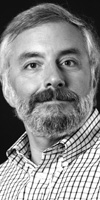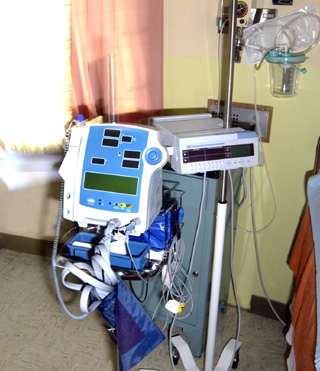
DJC.COM
April 19, 2007
Wal-Mart can teach hospitals about improving patient care
Anshen+Allen

Kerner
|
Headlines in medical research and development often emphasize breakthroughs providing better diagnostic and treatment tools for specific conditions and diseases, particularly for high-profile illnesses such as cancer or HIV/AIDS. Perhaps less noticed, there are several equally far-reaching issues affecting U.S. health care that technology is poised to address.
With the coming surge of elderly baby boomers, health care providers — already challenged by thin profit margins and growing demands — need to provide high-quality care to more people, especially those in greatest need. Portable technology opens the door to home health monitoring that can reduce patient visits and costs, and adapts well to those living with chronic diseases.

Photo courtesy of Agility Healthcare Solutions Radio frequency identification tags, commonly used by retailers such as Wal-Mart, allow hospitals to better track and manage hospital equipment. Items with RFID tags can even sound alarms when brought into the wrong patient’s room. |
A staggering number of people die in U.S. hospitals every year from preventable medical errors. Estimates range from 60,000 to over 100,000 deaths annually. Inventory-tracking technology already in widespread use promises a solution to medication errors.
Those unhappy about long waits for doctor appointments in institutional surroundings may see their experiences improve as hospitals upgrade their data networks to offer service more often associated with hotels than medical centers.
Health care at home
An aging population, more people with chronic medical conditions, and growing health care expenditures all generate momentum towards telehome care and home monitoring devices. Existing technologies have important applications for patients required to manage their health with self-testing at home, especially senior populations and those in rural communities.
Home health care and point-of-care testing offer a special boon for monitoring and treating chronic diseases.
Today, a patient may test herself at home by placing a finger tip into a blood analyzer. It can automatically read her blood chemistry levels, then send the test results directly to her medical record over a wireless Internet or cell phone connection.
Based on results, her provider will be alerted when she needs to come in. This technology reduces routine patient visits while delivering needed care.
RFID in the hospital
Some of the largest inventory and supply systems in the world use sophisticated technologies to manage vast numbers of items arriving and departing from far-flung locations. Currently Wal-Mart, Target and the Department of Defense require their top vendors to place radio frequency identification (RFID) tags on all shipments for inventory management.
We are all familiar with the white plastic tag that gets removed from merchandise before we leave a store to prevent triggering an alarm. Those RFID tags provide automatic identification based on storing and remotely retrieving data.
Expanding on the capabilities of bar coding, RFID most commonly assists inventory tracking for items such as books, apparel and pallets. Its accuracy eliminates discrepancies between inventory records and physical inventory.
For collecting transit payments and electronic toll collection, remote readers scan RFID tags as passengers or vehicles pass through toll booths, using tag information to debit prepaid accounts.
In a health care setting, an IV bag or meds cup with an RFID tag could sound an alarm if it were brought into the wrong patient’s room. Offering benefits beyond bar-coding, active RFID tags both receive and transmit signals, and can contain more information. By including a product’s serial number, RFID enables tracking the path of specific objects.
At the Pensacola Fleet Hospital in Iraq, the U.S. Navy adopted an RFID system to replace a labor-intensive system for locating patients.
Using RFID-enabled wristbands, hospital personnel can identify, locate and retrieve updates on the status of their patients. The system supports better patient care by keeping vital information with each patient, and tracking patients’ locations automatically.
At St. Clair Hospital in Pittsburgh, nurses, with the help of handheld computers, use bar code and RFID scanners to administer bedside medication. Medical errors are prevented and nurses save time with automatic charting to the electronic medical record system. The system is being expanded to check blood transfusions and label lab specimens.
In Springfield, Ore., Sacred Heart Medical Center is adopting a bar code system that links patient medical records and the billing system. It will help track inventory, ensure that supplies and medications go to the right patients, and bill based on actual use.
RFID technology offers many applications in health care: tracking and managing medical and IT equipment; locating staff or patients in real time; tracking fluids and specimens; monitoring sterilizing of medical surgical equipment and cleaning of beds and garments; and identifying correct prescription bottles and doses for blind or visually impaired people. As RFID gains wider use in health care, its potential applications will be confirmed and new uses will be discovered.
Hospital or hospitality?
Participants in a recent pilot program called Starbucks Express could order their custom drink online or by phone and find it waiting when they arrived at the drive-through. Their credit card account was automatically charged. Health care can learn from this pioneering effort at customer satisfaction.
For instance, Anshen+Allen is working with a regional health care provider on new ways to enhance the patient’s experience.
The scenario begins in the parking garage as we swipe our smart card in a reader. This alerts the entire medical center to our arrival: our medical record pops up in the department where we have our appointment, so they know to prepare the exam room, or any scheduled procedures. The greeters and receptionists also know we have arrived, and recognize us by our photo on their handheld computer. If our appointment is running late, they’ll let us know, and suggest a complimentary drink at the coffee shop.
Is this just window dressing on an experience most of us would still prefer to skip? Perhaps, but health care institutions find that making patients comfortable during their visits and treatments actually reduces stress and improves outcomes. In addition, patient satisfaction scores are a critical benchmark in organizations’ increasingly competitive drive to capture limited market share.
Bottom-line benefits
Health care makes up over 15 percent of the U.S. economy, and has traditionally been a late adopter of information technology.
Yet as applications gain acceptance and technology prices drop, their benefits — improving patient safety, improving the experience of receiving care, and streamlining business processes — will offer major incentives to health care organizations.
Today there are multiple competing issues within health care organizations: huge costs, slim profits and competition for patients and medical personnel. The impact of these technologies on the built health care environment will have a very real impact on both quality and bottom-line outcomes in months and years ahead.
Adam Kerner is a principal with Anshen+Allen, an architecture firm specializing in health care and academic facilities design.
Other Stories:
- Shifting health care needs bring technology to the fore
- Technological transformation is shaking up health care
- Keeping an airborne threat at bay
- New technologies cut heating, cooling costs
- Hospitals slowly warming to green design
- Change is coming. Are designers ready?
- Smarter structural design begins with the right analysis
Copyright ©2009 Seattle Daily Journal and DJC.COM.
Comments? Questions? Contact us.